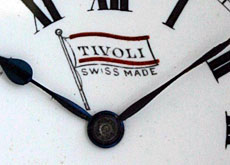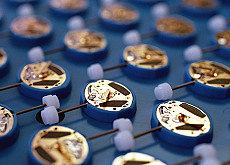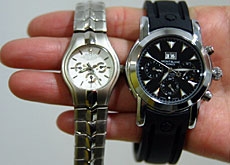Watch exhibition traces history of Swiss Made

An exhibition devoted to the Swiss Made brand in watchmaking is on display in the town of La Chaux-de-Fonds, just as the industry is making moves to strengthen the label.
The trademark appeared officially at the end of the 19th century but there was mention of it long before as a means of trying to fight counterfeiting.
Giving watches a distinctive label began as far back as 1601 in Switzerland. The corporation of Geneva watchmakers united to protect their profession, intending to combat poor workmanship.
It introduced a regulation that every watch made in the city had to bear the hallmark of the master watchmaker who put it together.
Tracing the roots of the Swiss Made label, the exhibition at the International Museum of Horology goes through the centuries from the beginnings of Swiss watchmaking in Geneva and the mountains of Neuchâtel.
In the mountains, watchmaking was less corporatist than in Geneva. But family workshops also produced watches that bore some sign of where they came from. La Chaux-de-Fonds, Le Locle, but also La Sagne or Le Convers entered into the annals of Swiss horology.
Wind of change
A fresh wind of change in watchmaking blew in from the United States in the middle of the 19th century. The Americans were to bring into the industry the knowledge they had gained in the production of firearms.
“Colts, so famous in the American West, served as models when it came to mass production. The majority of their parts were interchangeable,” said Jean-Michel Piguet, one of the museum curators.
The Centennial International Exhibition held in Philadelphia in 1876 and the mushrooming of American watch manufacturers gave Swiss watchmakers something to think about. To combat the increasing clout of their American rivals, they went in search of precision and then created a label to protect it.
Around 1880 Swiss Made was born – the term in English because the competition was from the US. Factories producing watch blanks also appeared, and movement parts could be – and were – assembled elsewhere.
When publicity began to become more international at the end of the 19th century, more pressure was put on Swiss watchmakers. Brands such as “Marvin” or “Urania” boasted about the reliability of their products.
Swiss precision
Publicity for Marvin, for example, guaranteed a “Swiss precision watch that was undisturbed by changes in temperature”.
At the same time, the necessity to better protect the values demanded by the Swiss watchmaking industry – quality, precision, durability – led the Swiss government to introduce in 1880 a first law on the protection of brands.
It was only during the 20th century that Swiss Made found its definitive place at the bottom of the watch dial. There was never any question of changing the language.
“From a graphic point of view, the short English term was well suited because it took up little space on the dial,” Piguet told swissinfo.
Finally, in 1971, Swiss Made acquired a legal basis. A watch is only considered Swiss if it fulfils certain conditions concerning the production and assembly of the movement, as well as final control.
Bad workmanship
The problem of bad workmanship encountered by Geneva watchmakers in 1601 has lost none of its topicality. The museum exhibition displays some Omega and Rolex watches produced by counterfeiters who did not go as far as putting Swiss Made on the dial.
“These examples date from a time when the Swiss Made argument was less important. Today, nearly all fakes bear the label,” Piguet said.
To fight against this “business” that has an annual production of 40 million imitations and causes losses estimated at SFr800 million ($661.95 million), the Federation of the Swiss Watch Industry came out in favour of strengthening the Swiss Made label at the end of last month.
The irony of history is that in the 18th century the Swiss also made imitation watches, Piguet noted. They are historic pieces which also have their story to tell in the museum’s collection.
swissinfo, Carole Wälti
The Swiss watchmaking industry makes on average 25 million watches a year.
There are 40 million fake watches produced annually around the world, with 70% coming from China.
In 2006, the Swiss watchmaking industry had another record year with exports reaching SFr13.7 billion ($11.4 billion). This is 10.9% up on 2005.
The number of employees in the sector rose by 6.5% last year to 44,444 – about a half less than in 1970.
The number of firms in the sector remained stable at 595.
The current regulations on Swiss Made date from 1971. They have been criticised in recent years, notably at the heart of the watchmaking sector, because they are considered too lax in the face of counterfeiting.
The Federation of the Swiss Watch Industry voted at the end of June to ask the government to adapt the ordinance on Swiss Made.
The draft proposes that at least 80% of the production costs for mechanical watches must be attributable to operations in Switzerland. For electronic watches the minimum would be 60 %. Technical construction and prototype development must also be carried out in Switzerland.
This strengthening of Swiss Made must be approved by the European Union in the framework of the free trade agreement between Brussels and Bern.

In compliance with the JTI standards
More: SWI swissinfo.ch certified by the Journalism Trust Initiative



You can find an overview of ongoing debates with our journalists here . Please join us!
If you want to start a conversation about a topic raised in this article or want to report factual errors, email us at english@swissinfo.ch.